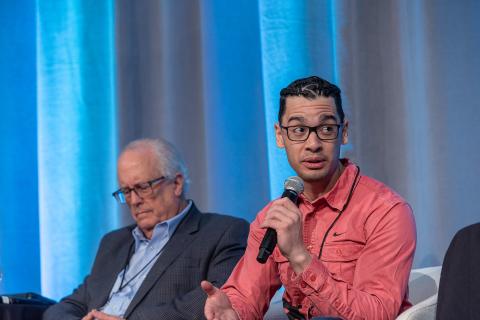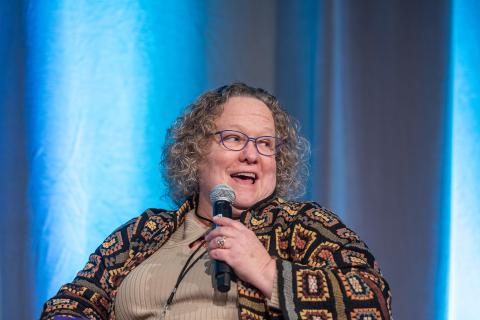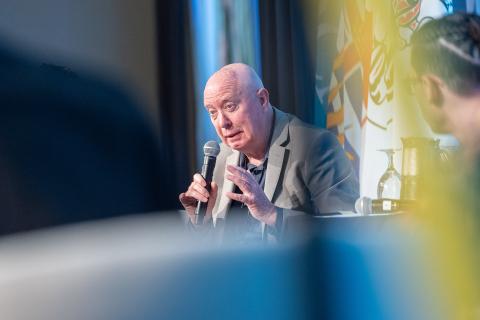A panel of six mayors discussed the view from their cities as BC faces population growth of one million people over eight years, and the suite of legislative initiatives designed to increase housing supply. They covered topics from the need for infrastructure to match increased density, and reimagining what it looks like to live in dense cities, to the need for legislatively protected affordable housing.
Panelists agreed on the need to dramatically increase housing supply. Burnaby Mayor Mike Hurley described 20,000 units already in the pipeline, of which 10,000 are below market. Those numbers are large for a city of any size, and Hurley expressed concern that the construction industry has the workforce capacity to deliver these homes quickly. “We’re told a million new people are coming over the next eight years. Hopefully 50% or more work in construction,” he said.
That’s capacity from the construction side, but local government staff also face real constraints.
Nelson Mayor Janice Morrison spoke up for smaller communities about the requirement to update housing plans that account for future growth. “I'm not too sure that Salmo—a town of 1,200—even has a housing plan. I mean, they don't have a planner, so…”
The most glaring omission from the suite of legislation introduced in fall 2023 is affordability. “There's nothing in the legislation that leads to affordability,” Mayor Hurley said.

Increasing supply alone will not lead to more affordability, mayors on the panel agreed. Richmond Mayor Malcolm Brodie cited his city building 50% more housing than they had population growth, while the average price increased by 67%.
In Nanaimo, “47% of the housing needs with our housing plans and projections are for people who can't afford the private market,” said Nanaimo Mayor Leonard Krog said.
In a later session, provincial Housing Minister Ravi Kahlon confirmed that legislation around rental protection and inclusionary zoning (to require or take cash in lieu of affordable housing) will be introduced in the spring 2024 legislative session. Details on planned legislation have not been shared.
While some of the initiatives are applauded — notably, transit-oriented area density, which “That is the future. We all know it, and it has to be done. So that's a very good thing,” Mayor Krog said. But several unintended consequences have been pointed out by local governments that they wish had been caught sooner in the process.

“The engagement that we got was the press releases on the government website,” said Langley City Mayor Nathan Pachal. Much like local governments elicit public engagement, Pachal would have liked to see the Housing Ministry give opportunity for input, even on a rushed timeline. “When we go through public hearings—and we've all been through those—there's always really good stuff that you can pull out of that and incorporate into policy.”
Mayor Krog, tempered his critique on the engagement, acknowledging that, “Life is a river that never stops flowing. You're trying to build a canoe while you’re floating on the river, trying to fix something that is already in movement, and is not going to stop for you. So, I am sympathetic to what the government's tried to do.”
Building livable communities to address the existing housing crunch and accommodate the incoming million new residents will require reimagining what cities will look like.
“As we confine people into smaller and smaller private spaces, we look more to our responsibility to create larger and more inclusive social and public spaces,” said Victoria Mayor Marianne Alto.
In Langley, Mayor Pachal’s council has already been working to develop transit dense areas to support more rapid transit. “Regardless of if we take action or not, people are still moving here,” Pachal said. Planning for a mix of density, transit, amenities and public spaces is a matter of, “Do we give them a good quality of life, or are people going to be stuck in overcrowded housing?”
Along with the nicer to talk about qualities of life—parks, transit, schools—are underground pipes that in many communities are beyond their useful life or beyond capacity.
Finally, with the Province’s move to increase “gentle density” through small-scale multi-unit housing is the reality that many people will be renting private dwellings. “You have to have a more efficient and effective residential tenancy branch, so that the bad landlords and the bad tenants and the good tenants and the good landlords can all get access to really speedy justice,” Mayor Krog said.


